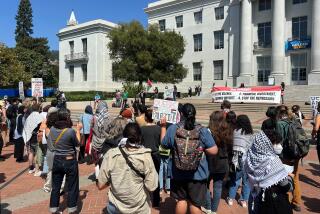Pioneering Professors Still ‘Live and Work’ for Students
- Share via
They were the rebels. The rabble-rousers. The pioneering professors who carved a college from squash fields and orange groves.
And they loved to teach.
In the beginnings of Cal State Northridge, a group of 40 teachers, many of them young, carefree and intolerant of bureaucracy, came together to create a different kind of school, one with strong ties between teachers and students. In fact, those first professors urged the architect not to design large lecture halls because they favored small classes.
Back then, recalled history professor Julian Nava, the college was like springtime, all green and pregnant with possibility.
“I still believe that the first staff was the strongest,” Nava said. “We shared this great camaraderie because we were so excited about building something new.”
Nava and biology professor Peter Bellinger are the only two of those original 40 professors who still teach at CSUN. Bellinger also remembers that hopeful time.
“That’s when things really got started,” he said.
Though their legacy is evident in everything from the building design to curriculum, Nava and Bellinger believe the transformation from bare-bones campus to modern institution has left behind an early, rustic charm.
But having outlived two earthquakes, several administrations and painful budget cuts, both men agree the reason they came to CSUN is the reason they’ll never leave.
Quite simply, they’re teachers.
Before coming to California in 1958, Bellinger was teaching biology at Yale University in Connecticut. He was invited to consider coming to what was then San Fernando Valley State College. At the time, Bellinger knew his interests centered on teaching, and was uncertain where his career at Yale was headed, since the Ivy League school emphasized research.
So he headed west and joined a biology department of just two men and one course, introductory biology. Bellinger and John Reardon designed the course for all students.
Ten years ago, another introductory course was created, but for biology majors and pre-med students. That course is more specialized--and tougher--than the basic class, and Bellinger worries it may be too intimidating for some freshmen and might discourage them from pursuing their interests in biology.
“When I came, there was one course for everybody,” he said. “It was much more uniform. Then we changed that. Sometimes, I’m still not sure that was the right move.”
When reminiscing about the history of CSUN, Bellinger is a man of few words. “Forty years is not such a big deal,” said Bellinger, 77. But start talking about the trends in population biology or the life cycle of a praying mantis and he can’t stop.
Forty years ago, he came to Northridge to start something new, and when that group of freshmen walks through his doors every year, he once again is starting something new.
“I don’t see any reason to leave.” he said.
At first glance, Bellinger and Nava appear as different as Intro to Entomology and Western Civilization II.
Bellinger is unassuming and enjoys the privacy of his personal life and Chatsworth home. Nava is loquacious and outspoken and constantly trekking the globe for social causes. A year ago he flew to Cuba, and just last week he returned from Tibet.
Nava, a U.S. ambassador to Mexico in the Carter Administration, had graduated from Harvard and was teaching at the University of Puerto Rico when he got the call. He was 29 when he accepted the job at CSUN.
Over the years, Nava has seen the history department’s fortunes rise and fall with economics or student tastes.
The department was hit hard in the early 1970s, when students shifted out of humanities and social sciences and bolted into business, computer science and engineering. The number of CSUN students majoring in history plunged from 1,500 students in 1968 to 600 students in 1975. Some professors lost their jobs.
Nava said budget cuts followed, and tenured faculty became costly. To the dismay of many on the respected history staff, the university began hiring a steady stream of part-time lecturers instead of full-time professors. While some saw the lecturers as a healthy infusion of new blood, Nava saw the practice as unfair not only to lecturers, who are paid dismally, but also to students.
“It looks good on paper because students get taught,” said Nava. “But it lowers the quality of education. The lecturers are experienced, but because they’re part time, they don’t have the same dedication as full-time professors.”
Indeed, the school has evolved in ways the original professors could not foresee. But, for Nava and Bellinger, CSUN is the house they built, and students are family.
“We live and work for them,” Nava said, “and I can’t imagine anything else I’d rather be doing.”
More to Read
Sign up for Essential California
The most important California stories and recommendations in your inbox every morning.
You may occasionally receive promotional content from the Los Angeles Times.










